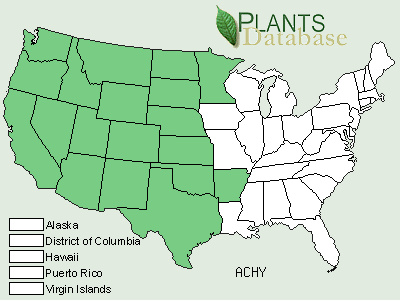(Photos from Great Bear Native Plants, Map from USDA-PLANTS database)
Achnatherum hymenoides, commonly known as Indian ricegrass, is a native cool season, bunchgrass that grows in dry plains and mountain habitat in the central and western United States and southwest Canada. You’ll often find Indian ricegrass growing in sagebrush, juniper and ponderosa pine-dominant plant communities. At times, Indian ricegrass even establishes as the dominant plant species in harsh, dry rangeland habitat. Indian ricegrass thrives in low-precipitation areas that receive from 6 to 20 inches of rainfall annually and can establish at elevations ranging from 2,000 to 10,000 feet. This hardy little member of the Poaceae plant family is one of the most charming native grasses we grow at Great Bear Native Plants!
Grasses can be intimidating to positively ID, but Indian ricegrass has some distinguishing features that make it a relatively easy grass to identify. These little bunchgrasses grow roughly 1 to 2 feet tall. They have smooth, thin leaf blades that are often tightly in-rolled which makes them look like long, straight tubes rather than flat leaf blades. The inflorescences of this species are what makes it particularly distinguishable amongst grass species. Indian ricegrass plants have open, branching panicles that range from 10-20 cm long, with hair-like spikelets that branch off the panicles. Once Indian ricegrass has gone to seed each spikelet along the panicle ends in a single fat, dark brown seed covered in light hairs. The rather whimsical, open nature of Indian ricegrass flowering stalks, each with many thin, seed-tipped spikelets give these plants a undulating appearance. On windy days, you’ll see Indian ricegrass plants shimmer and dance in the full sun.
As it’s common name implies, Indian ricegrass was used by many Native American peoples. Seeds were used as a staple grain by several cultures and acted as a substitute food for others. The mature seeds of Indian ricegrass plants were commonly gathered, ground into meal and then baked into bread or eaten as porridge or used as a component in other dishes. The high-protein content of Indian ricegrass seed makes it valuable for more than just humans though. It makes good winter forage for both livestock and wildlife and the seeds are also highly sought after by birds and small mammals.
Indian ricegrass also has a high restoration, reclamation and revegetation value on dry sites because of its drought tolerance and winter hardiness. The species is commonly used for restoration of sites that are susceptible to wind erosion. It is also a recommended species for roadside plantings because of its attractive seedheads and ability to stabilize soil.
This species also makes an attractive addition to xeric and rock gardens. Aside from being a sought after ornamental grass for xeric landscaping, Indian ricegrass plants attract birds and butterflies and can also provide winter interest to gardens. For water wise, low maintenance landscaping, we recommend plating it with other non-aggressive, drought tolerant native forbs, grasses and shrubs.
Planting Notes
Plant Indian ricegrass in full sun locations with deep, well-drained sandy or rocky soil.
Water well at first to establish, then Indian rice grass can generally fend for itself.
Indian ricegrass is a relatively short-lived bunchgrass, but should reseed to maintain presence in a garden or range setting.
Avoid planting Indian ricegrass with aggressive grasses and forbs
Planting Buddies
Consider planting Indian ricegrass with:
Munro’s Globemallow (Sphaeralcea munroana )
Buckwheats (Eriogonum spp.)
Palmer’s penstemon (penstemon palmeri)
Colorado four O’clock (mirabilis multiflora)
Antennaria microphylla (Rosy pussytoes)
Prairie Clovers (Dalea spp.)
Blue grama (Bouteloua gracilis)
Idaho fescue (Festuca idahoensis)
Apache plume (Fallugia paradoxa)
Leadplant (Amorpha canescens)
Sources:





Comments